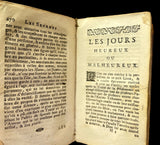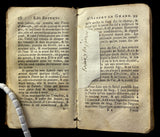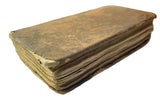FULL TITLE: Les Admirables Secrets d'Albert le Grand: Contenant plusieurs traites sur la conception des femmes, des vertus des herbes, des pierres précieuses & des animaux.
Free Worldwide Shipping
Language French
Written by Albert Le Grand
Published by Les Heritiers de Beringos fratres, Lyon, France; 1729
DESCRIPTION:
[Grimoire, Occult, Book of Secrets]. Albert Le Grand. Les Admirables Secrets d'Albert le Grand: Contenant plusieurs traites sur la conception des femmes, des vertus des herbes, des pierres précieuses & des animaux. Lyon: Les Heritiers de Beringos fratres, 1729. 14 cm, [24], 306 (missing p. 95/96), [6] pages, [3] leaves of plates: engrv.; 12°; title printed in red and black, with engraved headers and footers, decorated initials, and three full-page engravings, hors-text, inserted at p. 25, p.169, and p.225; bound with contemporary full-calf leather boards.
Les Admirables Secrets d'Albert le Grand [The Grand Albert] is traditionally but wrongly attributed to Albertus Magnus, and also sometimes attributed to Albertus de Saxonia. According to bibliographer Jacques Charles Brunet, "Among popular books, it is the most celebrated. It is quite natural that the Book of Secrets was attributed to Albert the Great, because this doctor, very learned for his time, had, among his contemporaries, the reputation of being a sorcerer."It is only natural that the Book of Secrets was attributed to Albert the Great, because this doctor, very learned for his time, had, among his contemporaries, the reputation of being a sorcerer." [Engl. transl. Fr.]
This magical textbook, or grimoire, is a collection of various works, including Christophe Landré's Oecoiatrie and part 3 of Michael Scott's Physionomia. Books 1 and 2 are a translation of De secretis mulierum, Liber aggregationis, and De mirabilibus mundi.
First translated into French in the 1500s, the book became a popular text on witchcraft, demons, spirits, and other secrets (or recipes) in the early 18th century. The 1703 Cologne edition was printed with engravings from the Beringo brothers. These 16th-century printers were associated with the publication of various treaties on magic and reprints of Cornélius Agrippa's works. In the 17th and 18th centuries, due to the printer's occult associations, many books appeared falsely under the names of the Beringo brothers and their successors, adding mystique to the texts. According to H. & J. Baudier's Bibliographie Lyonnaise, the 1729 edition is among these popular false imprints (Vol. 3, 1897, p. 33).
|
CONDITION: Fair-good condition; bound in contemporary calf-leather boards, leather worn and scuffed, with inner boards exposed at corners and edges, head and foot of spine chipped with lacks; old bookseller pencil notes on front endpapers; text cracked and shaken at several junctures; dog-eared and folded corners (top and bottom); several pages split in half, p. 4, 20, & 11; two pages with water damage, paper thinned and text dissolved; p.71 loose, hanging on by top corner; missing one page, p. 95/96; page edges have small rips and tears, with tear at p. 105, and marginal tear p. 163. (see photographs) References: [OCLC 668147,14299461, 110433414685; Baudier, H & J, 1897, v. 3, p. 55].
|

































